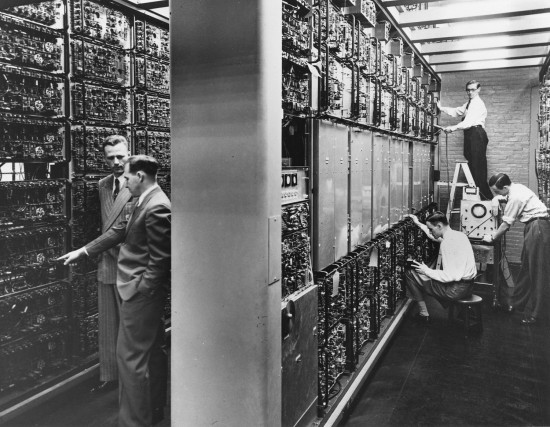History of Computers - MIT's Whirlwind Computer
Page created by Elizabeth Awad
Introduction
MIT's Whirlwind was a computer developed by the Servomechanisms Laboratory at MIT. The Project originally started out for the development of a flight simulator for training, but shifted focus to becoming a digital computer. Through working on this computer, magnetic storage memory was created to increase the speed and accuracy of the computer.

Overview
MIT's Whirlwind Computer started out as research and was initiated by the Office of Naval Research to develop a universal flight training simulator during World War II. It started in the MIT Servomechanisms Laboratory in 1944 and through time the grant became focused on developing a high speed digital computer [1]. The project was led by Jay Forrester, and while working on the computer he started to develop a new type of 2D or 3D form of storage. Forrester created random-access, coincident-current magnetic storage and was granted a patent for this new type of memory in 1956 [2]. After reviewing the work of An Wang, Forrester built an array that passed current through a ring to magnetize the ring. This worked, but it was too slow until he came up with the idea to thread each ring onto a unique pair x,y wire and a third wire was connected to all the other wires to read or write a bit. This new discovery became the standard memory device for digital computers, replacing electrostatic storage tubes. Because of the change to magnetic core memory, this computer was able to operate on higher levels of speed and were more reliable. This invention was crucial to the development of this computer and other computers because it allowed the computer to be more reliable [3]. The Whirlwind Computer was completed in 1951 and later that year Project Whirlwind stopped working in the Servomechanisms Laboratory and branched off to become The Massachusetts Institute of Technology Digital Computer Laboratory. The US Air Force helped finance The Whirlwind Computer and

 This is the memory bank of magnetic cores for the Whirlwind Computer
This is the memory bank of magnetic cores for the Whirlwind Computer
Significance
The MIT Whrilwind Computer was important because it was the first digital computer to operate and compute in real time. It could add two 16-bit numbers in two microseconds and could multiply them in twenty microseconds [4]. It also displayed a graphics display on a video terminal and used Core Memory for RAM because of Jay Forrester's invention of magnetic storage. This computer also used the first light pen to read the position of a dot on the screen. The Whirlwind computer was the fastest computer of it's time and The Whirlwind Computer was also a key component to the development of SAGE (Semi-Automatic Ground Environment) air defense system. These developments in core memory and RAM used in the Whirlwind Computer provide the basis for computers now. The magnetic core memory was used in computers until the beginning of the 1970s where it was replaced by integrated semiconductor RAM chips.
References
- ↑ http://ethw.org/Milestones:Whirlwind_Computer
- ↑ https://libraries.mit.edu/archives/research/collections/collections-mc/mc665.html
- ↑ https://www.ll.mit.edu/about/History/earlydigitalcomputing.html
- ↑ http://history-computer.com/ModernComputer/Electronic/Whirlwind.html
External Links
https://www.ll.mit.edu/about/History/earlydigitalcomputing.html
http://ethw.org/Milestones:Whirlwind_Computer
http://libraries.mit.edu/archives/exhibits/project-whirlwind/index.html
https://en.wikipedia.org/wiki/Magnetic-core_memory